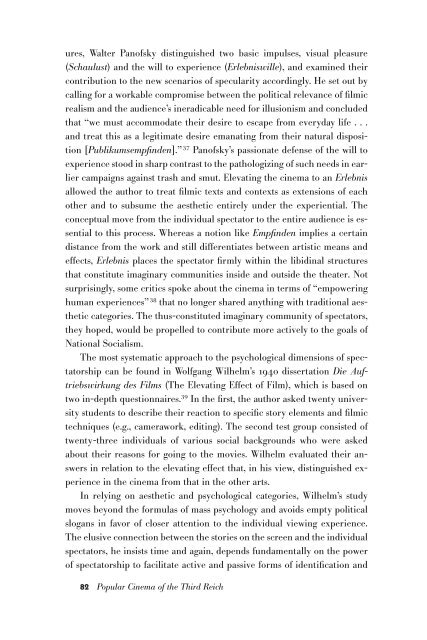You also want an ePaper? Increase the reach of your titles
YUMPU automatically turns print PDFs into web optimized ePapers that Google loves.
ures, Walter Panofsky distinguished two basic impulses, visual pleasure<br />
(Schaulust) and the will to experience (Erlebniswille), and examined their<br />
contribution to the new scenarios of specularity accordingly. He set out by<br />
calling for a workable compromise between the political relevance of filmic<br />
realism and the audience’s ineradicable need for illusionism and concluded<br />
that “we must accommodate their desire to escape from everyday life . . .<br />
and treat this as a legitimate desire emanating from their natural disposition<br />
[Publikumsempfinden].” 37 Panofsky’s passionate defense of the will to<br />
experience stood in sharp contrast to the pathologizing of such needs in earlier<br />
campaigns against trash and smut. Elevating the cinema to an Erlebnis<br />
allowed the author to treat filmic texts and contexts as extensions of each<br />
other and to subsume the aesthetic entirely under the experiential. The<br />
conceptual move from the individual spectator to the entire audience is essential<br />
to this process. Whereas a notion like Empfinden implies a certain<br />
distance from the work and still differentiates between artistic means and<br />
effects, Erlebnis places the spectator firmly within the libidinal structures<br />
that constitute imaginary communities inside and outside the theater. Not<br />
surprisingly, some critics spoke about the cinema in terms of “empowering<br />
human experiences” 38 that no longer shared anything with traditional aesthetic<br />
categories. The thus-constituted imaginary community of spectators,<br />
they hoped, would be propelled to contribute more actively to the goals of<br />
National Socialism.<br />
The most systematic approach to the psychological dimensions of spectatorship<br />
can be found in Wolfgang Wilhelm’s 1940 dissertation Die Auftriebswirkung<br />
des Films (The Elevating Effect of Film), which is based on<br />
two in-depth questionnaires. 39 In the first, the author asked twenty university<br />
students to describe their reaction to specific story elements and filmic<br />
techniques (e.g., camerawork, editing). The second test group consisted of<br />
twenty-three individuals of various social backgrounds who were asked<br />
about their reasons for going to the movies. Wilhelm evaluated their answers<br />
in relation to the elevating effect that, in his view, distinguished experience<br />
in the cinema from that in the other arts.<br />
In relying on aesthetic and psychological categories, Wilhelm’s study<br />
moves beyond the formulas of mass psychology and avoids empty political<br />
slogans in favor of closer attention to the individual viewing experience.<br />
The elusive connection between the stories on the screen and the individual<br />
spectators, he insists time and again, depends fundamentally on the power<br />
of spectatorship to facilitate active and passive forms of identification and<br />
82 Popular Cinema of the Third Reich

















